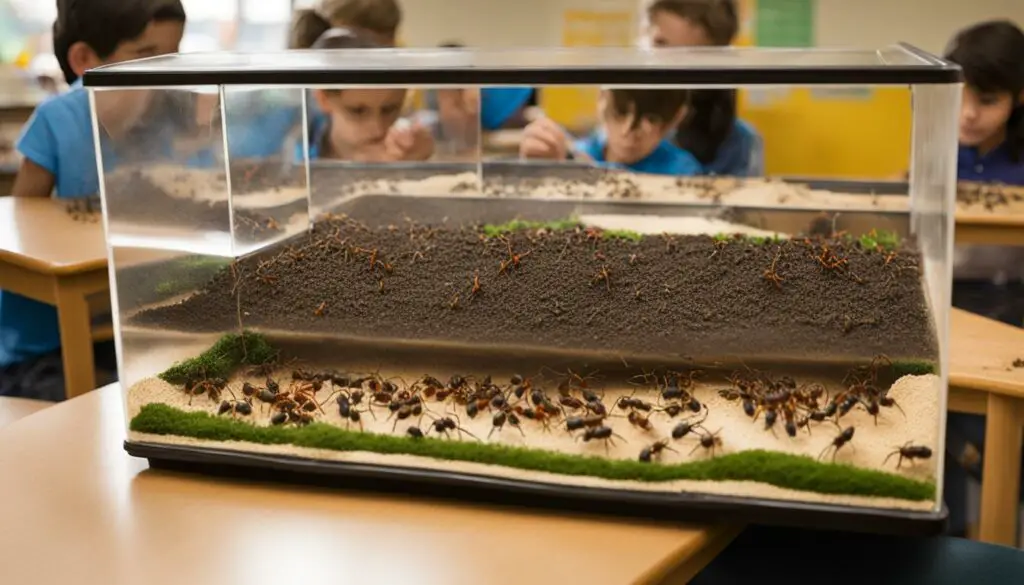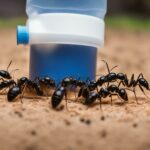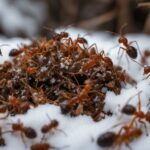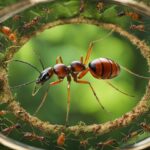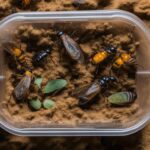Ants can be fascinating and educational classroom pets. They offer numerous benefits, such as promoting learning and social development, while adhering to science and math standards. Despite their prominence in the environment, ants are often underutilized as teaching tools in the classroom. By incorporating ants into the classroom, teachers can create a unique and interactive learning experience for their students.
Key Takeaways
- Ants as classroom pets offer numerous benefits for students’ learning and development.
- Observing ants in the classroom can foster curiosity, critical thinking, and a love for nature.
- Ants can be used as a subject for science projects, allowing students to engage in the scientific method.
- Caring for ants teaches students responsibility, consistency, and attention to detail.
- Interacting with ants can have a positive impact on students’ emotional well-being.
The Educational Value of Ants as Pets
Ants provide a unique and valuable educational experience for students. As classroom pets, they offer a hands-on opportunity for students to learn about insect behavior, social organization, and environmental impact. By observing and caring for ants, students can gain a deeper understanding of the natural world and develop important scientific skills.
Ants serve as excellent teaching tools, allowing students to explore various scientific concepts. They can observe ant colonies and understand their social hierarchy, as well as learn about their unique adaptations. By conducting experiments and observations on ant behavior, students can actively engage in the scientific method, collect data, and draw conclusions.
The Benefits of Ants as Classroom Pets:
- Hands-on learning experience
- Opportunity to explore insect behavior and social organization
- Develops scientific skills and understanding of the natural world
- Engages students in the scientific method through experiments and observations
By incorporating ants into the classroom, teachers can create a dynamic and interactive learning environment that sparks curiosity, fosters critical thinking, and promotes a love for science and nature.
Ant habitats, such as ant farms, can be used as a teaching tool to explore concepts in ecology, biology, and environmental science. Students can learn about the interdependence of organisms, the role of insects in ecosystems, and the impact of environmental factors on ant behavior. The interactive nature of ant habitats allows students to make abstract concepts more tangible and relatable, enhancing their overall learning experience.
In conclusion, ants offer a myriad of educational benefits as classroom pets. From enhancing scientific understanding to promoting critical thinking and curiosity, ants provide a unique opportunity for students to engage with the natural world and develop important skills. By incorporating ants into the curriculum and creating a safe and educational environment for the ants, teachers can create a memorable and transformative learning experience for their students.
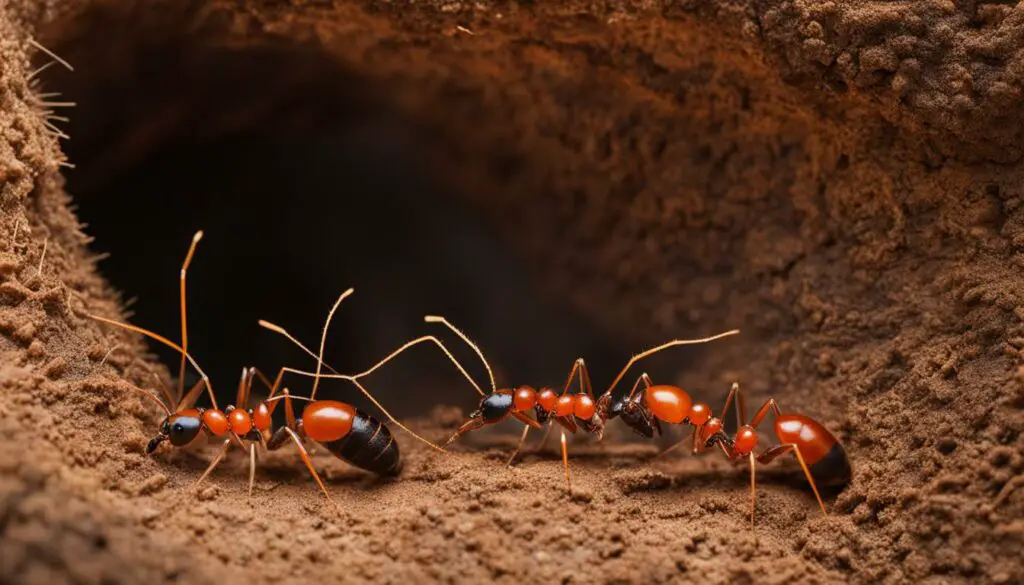
Benefits of Observing Ants in the Classroom
Observing ants in the classroom provides several benefits for students. It allows them to witness firsthand the behavior and interactions of these fascinating insects. Students can observe ant colonies, understand their social hierarchy, and learn about their unique adaptations. This hands-on experience fosters curiosity, critical thinking, and a love for nature. Ant farms provide a safe and controlled environment for students to closely observe ants and their activities.
By observing ants in the classroom, students can develop important scientific skills. They learn how to make observations, ask questions, and draw conclusions. This process mirrors the scientific method, encouraging students to think critically and analytically. Through their observations, students can also make connections to various scientific concepts such as animal behavior, ecology, and adaptation.
The benefits of observing ants in the classroom extend beyond scientific education. Ants provide a sense of wonder and awe, sparking students’ curiosity about the natural world. They encourage empathy and a deeper understanding of the interconnectedness of all living creatures. Observing ants can also have a calming effect on students, promoting relaxation and reducing stress. Overall, observing ants in the classroom offers a unique and engaging learning experience that enhances not only scientific knowledge but also emotional well-being.
The Fascinating World of Ants
Ants are social insects that live in highly organized colonies. They exhibit complex behaviors and have intricate communication systems. By observing ants in the classroom, students can witness the intricate workings of a society and gain a better understanding of teamwork, cooperation, and division of labor. Ants have different roles within the colony, such as workers, soldiers, and the queen. Students can observe how each ant contributes to the survival and success of the colony.
Ants are also fascinating creatures when it comes to their unique adaptations. From their intricate tunnels to their ability to carry objects many times their own body weight, ants have evolved impressive skills that allow them to thrive in their environment. By observing ants in the classroom, students can gain insight into these adaptations and how they contribute to the ants’ survival and success as a species.
| Benefits of Observing Ants in the Classroom |
|---|
| Enhances scientific skills such as observation, questioning, and critical thinking |
| Connects to various scientific concepts such as animal behavior, ecology, and adaptation |
| Sparks curiosity, empathy, and a love for the natural world |
| Promotes relaxation and reduces stress |
| Teaches important life lessons on teamwork, cooperation, and division of labor |
| Provides insight into unique adaptations that allow ants to thrive in their environment |
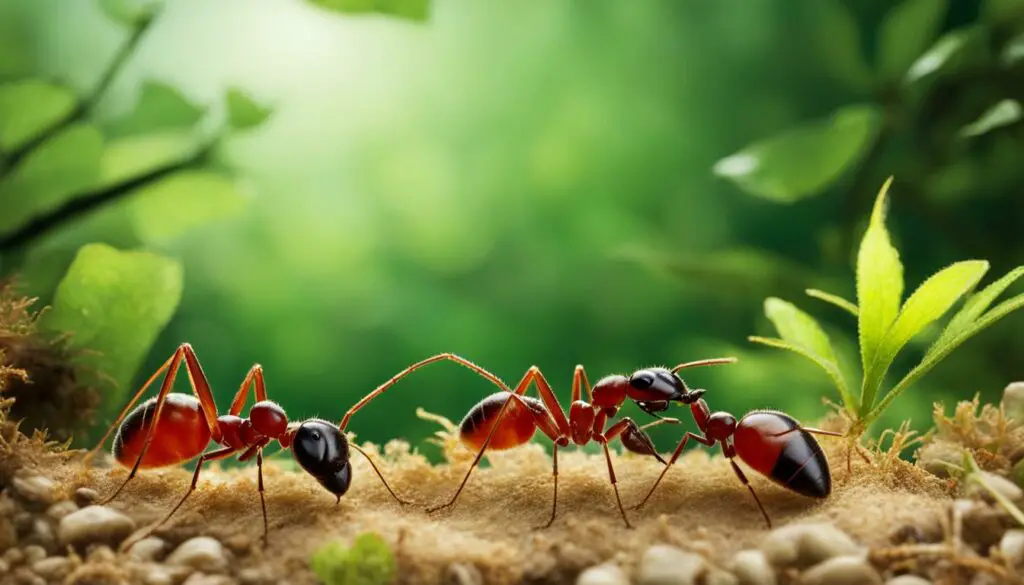
Observing ants in the classroom offers a unique and engaging learning experience that enhances scientific knowledge and emotional well-being.
Overall, incorporating ants into the classroom through observation provides students with a deep appreciation for the natural world and its intricate ecosystems. By witnessing the behavior and adaptations of ants, students develop essential scientific skills and gain a sense of wonder and curiosity. Ants offer a valuable teaching tool that promotes critical thinking, empathy, and a love for nature.
Ants as a Science Project
Ants provide an excellent opportunity for students to engage in a science project that promotes curiosity, critical thinking, and hands-on learning. Conducting experiments and observations on ant behavior allows students to explore various scientific concepts and principles. They can investigate how ants respond to changes in their environment, such as light exposure or food availability, and analyze the data they collect to draw conclusions. By actively participating in the scientific method, students develop important scientific skills, such as data collection, analysis, and interpretation.
One possible science project involving ants is to study their preference for different types of food. Students can set up multiple feeding stations with different food options, such as sugar water, bread crumbs, and fruit. They can then observe which food sources attract the most ants and record their observations in a table or graph. This experiment allows students to explore concepts related to animal behavior, food preferences, and the role of sensory perception in decision-making.
Another science project idea is to investigate the impact of environmental factors on ant behavior. Students can create different microenvironments within the ant habitat by manipulating variables such as temperature, humidity, or light intensity. They can observe how ants respond to these changes in the environment and analyze their findings to understand how ants adapt to different conditions. This experiment helps students develop a deeper understanding of the relationship between organisms and their environment.
| Experiment | Materials | Procedure | Expected Results |
|---|---|---|---|
| Food Preference | Multiple feeding stations with different food options (sugar water, bread crumbs, fruit) | Observe which food sources attract the most ants | Record observations in a table or graph to determine the ants’ food preferences |
| Environmental Impact | Ant habitat, temperature control, humidity control, light source | Create different microenvironments within the ant habitat by manipulating environmental variables | Observe how ants respond to changes in temperature, humidity, or light intensity |
Ants provide an excellent opportunity for students to engage in hands-on learning and scientific inquiry. By conducting experiments and observations on ant behavior, students can explore various scientific concepts and develop important scientific skills. Ants serve as fascinating subjects for science projects, encouraging curiosity, critical thinking, and a deeper understanding of the natural world.
Teaching Responsibility through Classroom Pets
Introducing classroom pets, such as ants, provides an excellent opportunity to teach students about responsibility. By taking care of these living organisms, students learn the importance of accountability and nurturing. Assigning daily chores and rotating responsibilities among the students helps develop consistency, attention to detail, and commitment.
Teaching kids about responsibility with classroom pets goes beyond providing food and shelter. It involves instilling empathy and a sense of duty towards other living creatures. As students witness the impact of their actions on the ants’ well-being, they learn to approach their responsibilities with care and compassion.
“Caring for ants in the classroom not only teaches students about responsibility, but also fosters a sense of connection to the natural world,” says Dr. Jane Thompson, an educational psychologist.
When students are given the opportunity to care for living organisms, they develop a deep sense of empathy and a greater understanding of the interconnectedness of all living things.”
Through the collaborative care of classroom pets, students also learn important social and communication skills. They work together, communicate effectively, and share the responsibility of creating a nurturing environment for the ants. This cooperative learning approach not only enhances their teamwork abilities but also cultivates a sense of ownership and pride in their role as caretakers.
| Benefits of Teaching Responsibility through Classroom Pets |
|---|
| 1. Development of accountability and consistency |
| 2. Cultivation of empathy and compassion |
| 3. Enhancement of teamwork and communication skills |
| 4. Fostering a sense of connection to the natural world |
Teaching responsibility through classroom pets, such as ants, not only benefits students academically but also contributes to their personal development as caring and responsible individuals. By nurturing a sense of responsibility towards other living creatures, teachers empower students to become compassionate members of society.
Ants and Emotional Well-being
Interacting with classroom pets, such as ants, can have a positive impact on students’ emotional well-being. Spending time observing and caring for ants can help reduce stress and anxiety, promote a sense of calm, and improve overall mood. The presence of a classroom pet offers companionship and a sense of comfort to students. Ants can serve as a source of support and help create a nurturing and inclusive classroom environment.
When students engage with ants, they experience a sense of wonder and fascination. Watching the ants go about their daily activities can provide a calming effect, allowing students to momentarily escape from the pressures of their studies. The gentle movements and rhythmic behaviors of the ants can create a soothing and relaxing atmosphere in the classroom.
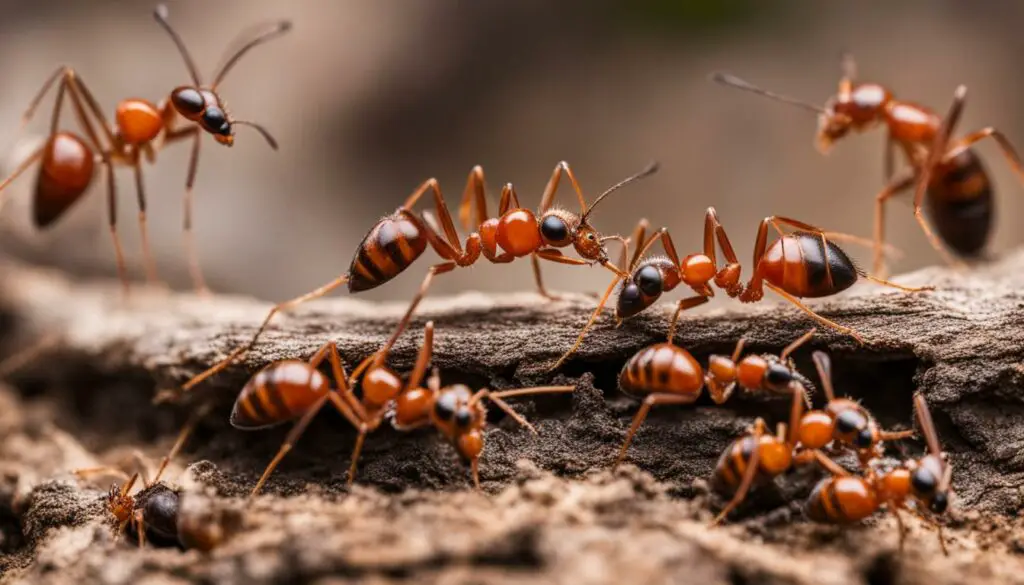
Interacting with ants can also promote empathy and compassion among students. As they observe the ants’ behavior and learn about their social structures, students gain a deeper understanding and appreciation for the interconnectedness of all living creatures. This understanding can foster a sense of responsibility and empathy towards the natural world.
The Benefits of Interacting with Classroom Pets
Interacting with ants and other classroom pets can have a profound impact on students’ emotional well-being. Research has shown that contact with animals can reduce stress levels, lower blood pressure, and improve overall mental health. The presence of classroom pets, such as ants, can provide a sense of companionship and emotional support for students, creating a positive and nurturing learning environment.
By incorporating ants into the classroom, teachers can help foster emotional well-being and create a balanced and holistic approach to education. The simple act of observing and caring for ants can bring joy, relaxation, and a sense of connection to students, while also promoting important life skills such as empathy, responsibility, and respect for all living creatures.
Enhancing Learning with Ants
Ants offer a multitude of educational benefits in the classroom, enriching the learning experience for students across various subjects. By incorporating ants into lesson plans, teachers can make abstract concepts more tangible and relatable, fostering curiosity, critical thinking, and active participation in the learning process.
The Educational Power of Ants
Ants provide a unique opportunity for students to observe insect behavior, social organization, and environmental impact. Through hands-on interaction, students gain a deeper understanding of the natural world and develop essential scientific skills. Ants can be used as teaching tools to explore concepts in biology, ecology, and environmental science, allowing students to connect theoretical knowledge with real-life observations.
For example, math lessons can be enhanced by incorporating activities such as measuring ant feeding patterns or calculating the weight of an ant colony. Science lessons can explore ant anatomy or investigate how environmental factors influence ant behavior. By integrating ants into the curriculum, teachers can create engaging and interactive learning experiences that leave a lasting impression on their students.
Transforming Learning Through Ants
Ants spark curiosity and encourage students to think critically. By observing and caring for ants, students develop important skills such as observation, data collection, and analysis. They learn to ask questions, make predictions, and draw conclusions based on their findings. Working with ants as classroom pets provides a unique hands-on experience that brings learning to life.
Additionally, ants promote active participation in the learning process. Students become actively engaged in their education as they take on the responsibility of caring for the ants, collaborating with their peers, and documenting their observations. This interactive approach fosters a deeper understanding of the subject matter and cultivates a love for learning.
Table: Enhancing Learning with Ants
| Subject | Examples of Ant-related Activities |
|---|---|
| Math | Measuring ant feeding patterns, calculating ant colony weight |
| Science | Observing ant behavior, investigating environmental factors |
| Language Arts | Writing creative stories about ants, researching ant facts |
| Art | Creating ant-themed artwork, designing ant habitats |
By incorporating ants into the classroom, teachers can create a dynamic and immersive learning environment that enhances students’ educational journey. Ants serve as valuable teaching tools, bridging the gap between theory and practice and igniting a passion for learning that extends far beyond the classroom.
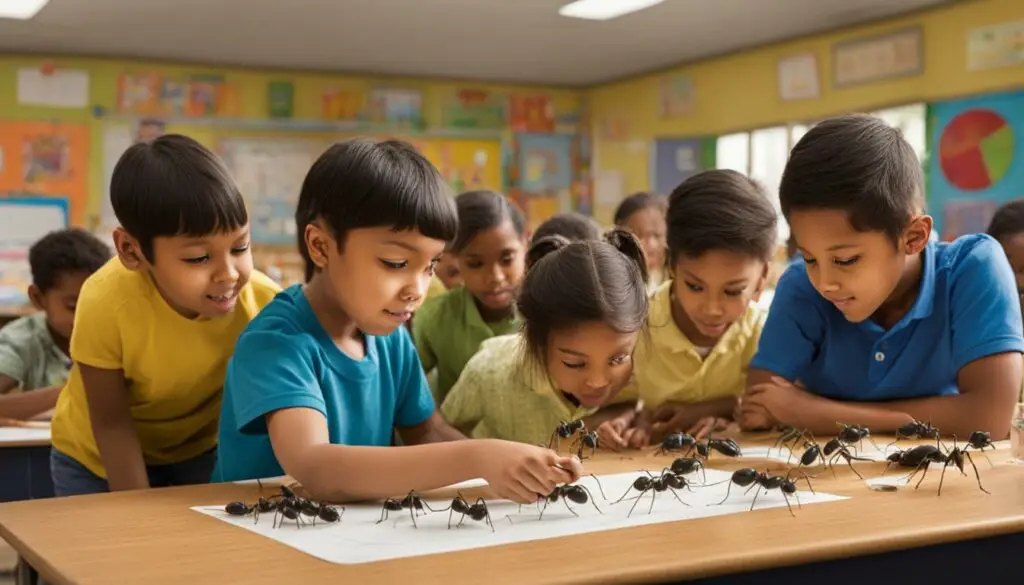
Choosing the Right Ant Species for the Classroom
When it comes to selecting ants as classroom pets, it’s important to choose the right species. Not all ants are suitable for educational purposes, so it’s crucial to consider factors such as size, ease of maintenance, and compatibility with the classroom environment. By choosing the right ant species, teachers can ensure a successful and rewarding experience for both the students and the ants.
One popular ant species for classroom settings is the Western Harvester ant. These ants are relatively large, making them easy to observe and study. They have fascinating behaviors and a well-defined social structure, which makes them ideal for educational purposes. Additionally, Western Harvester ants are relatively low-maintenance and can adapt well to different classroom environments.
Another important consideration is the availability of resources for the chosen ant species. Different species have different dietary and environmental needs, so it’s crucial to ensure that the ants can thrive in captivity. Teachers should research and understand the care requirements of the selected ant species, ensuring they are able to provide the necessary food, water, and habitat for their classroom pets.
| Ant Species | Size | Ease of Maintenance | Compatibility with Classroom Environment |
|---|---|---|---|
| Western Harvester Ant | Relatively large | Low-maintenance | Adaptable |
| Velvet Ant | Small | Moderate maintenance | Requires specific conditions |
| Pavement Ant | Small | Low-maintenance | Adaptable |
By considering the size, ease of maintenance, and compatibility with the classroom environment, teachers can select the right ant species for their educational needs. Remember, the welfare and well-being of the ants should always be a top priority, ensuring they have a safe and suitable habitat to thrive in.
Incorporating Ants into the Curriculum
Integrating ants into the curriculum is an effective way to make learning more engaging and relevant for students. By incorporating ant-related activities and discussions into various subjects, teachers can provide a unique and interactive learning experience. Let’s explore how ants can be integrated into different lessons:
Science:
In science, students can learn about ant anatomy, behavior, and their ecological role. They can conduct experiments to investigate how ants respond to different stimuli or environmental factors. Observing ant colonies can provide valuable insights into social organization, communication, and life cycles.
Math:
Ants can also be integrated into math lessons. Students can use ant feeding as an opportunity to practice measurement and calculation skills. For example, they can determine the amount of food required for a certain number of ants or calculate the average weight of ants in a colony.
Language Arts:
Ants can inspire creative writing activities. Students can write stories or poems from the perspective of ants, imagining their adventures or daily life. They can also research and write informative essays about different ant species or explore ant-related topics in literature.
Art:
Ants can serve as a source of inspiration for art projects. Students can create ant-themed artwork using various mediums, such as drawing, painting, or sculpture. They can also design ant habitats or construct models that represent the different aspects of ant colonies.
By incorporating ants into the curriculum, teachers can create a multidisciplinary learning experience that fosters curiosity, critical thinking, and creativity while deepening students’ understanding of various subjects.
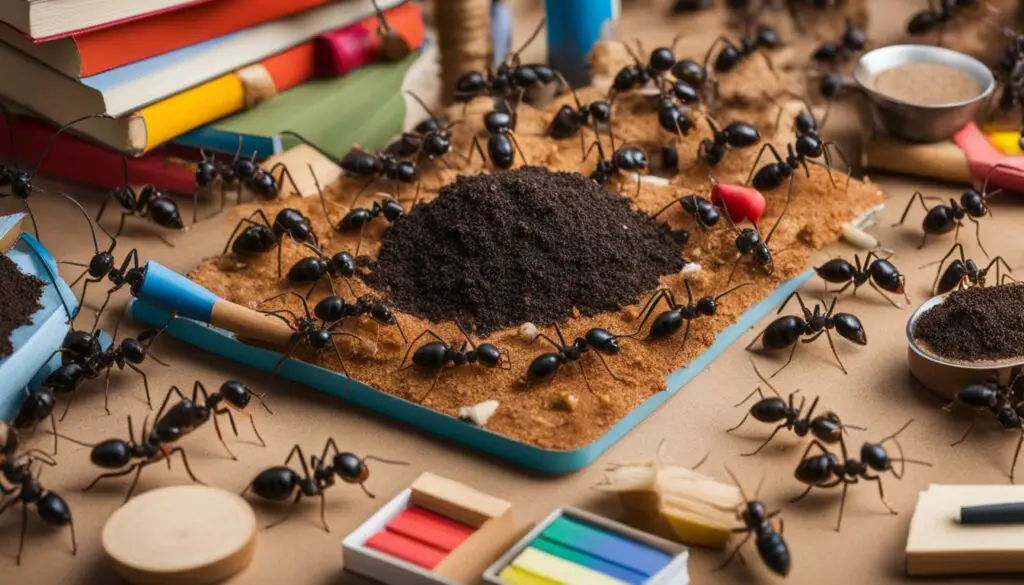
Setting Up an Ant Habitat in the Classroom
Creating an ant habitat in the classroom is an exciting and educational endeavor that requires careful planning and preparation. By providing a suitable environment for the ants, you can create a captivating and interactive learning experience for your students. Here are some important steps to consider when setting up an ant habitat in the classroom:
- Choose the right ant habitat: Select a suitable ant farm or habitat that meets the needs of the ants. Look for a well-ventilated enclosure with clear sides for easy observation. Ensure that it is escape-proof to prevent ants from venturing into unintended areas of the classroom.
- Research and select the appropriate ant species: Different ant species have different care requirements. Make sure to choose a species that is easy to care for and can thrive in the conditions provided in the classroom. The Western Harvester ant, for example, is a popular choice for its hardiness and adaptability.
- Provide the right substrate: Ants need a suitable substrate to create tunnels and chambers. Fill the habitat with a combination of sand and soil to mimic their natural environment. Make sure the substrate is moist but not overly wet to avoid mold growth.
- Offer a varied diet: Ants require a diverse diet to stay healthy. Provide them with a balanced diet of sugar-based foods, such as honey or sugar water, and protein-rich foods, such as small insects or commercially available ant food. Ensure a constant supply of fresh water.
By following these steps, you can create a safe and enriching habitat for your classroom ants. Remember to regularly monitor the habitat, clean it as needed, and make any necessary adjustments to ensure the well-being of the ants.
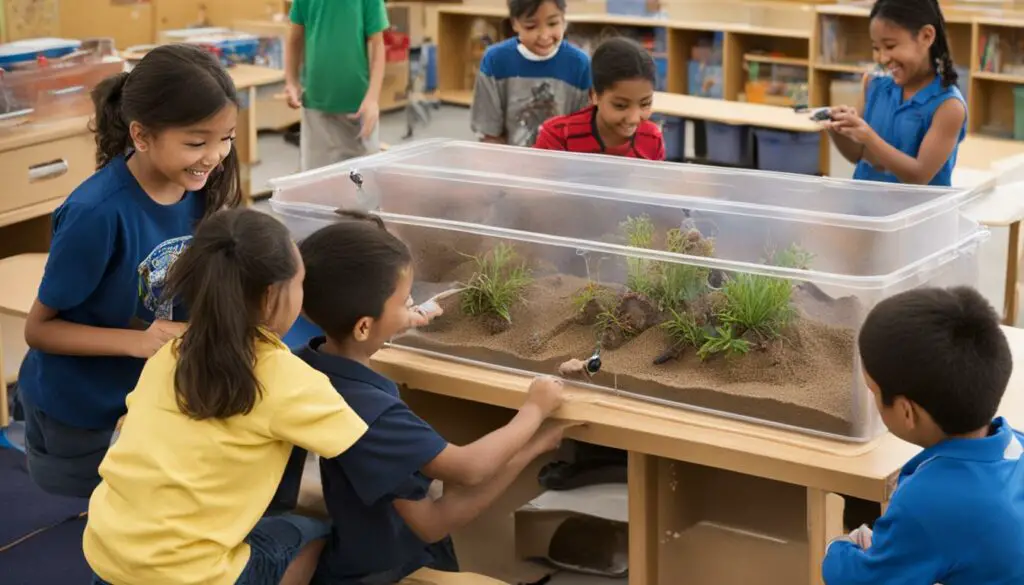
Benefits of Setting Up an Ant Habitat in the Classroom
Setting up an ant habitat in the classroom offers numerous benefits for both the students and the educational experience:
- Hands-on learning: Observing and caring for ants provides students with a hands-on learning experience that encourages curiosity, critical thinking, and scientific inquiry.
- Promotes responsibility: Taking care of the ants teaches students about responsibility, consistency, and attention to detail. They learn the importance of meeting the needs of living organisms and develop empathy towards other living creatures.
- Enhances science education: Ant habitats can be used as a teaching tool to explore various scientific concepts, such as ecology, biology, and environmental science. Students can investigate ant behavior, social organization, and the impact of environmental factors on ant colonies.
- Engages students in the learning process: Ants make abstract concepts more tangible and relatable, sparking curiosity and encouraging active participation in the learning process. Students can observe and document ant behavior, conduct experiments, and analyze data.
Overall, setting up an ant habitat in the classroom provides a unique and engaging learning opportunity that promotes scientific literacy, critical thinking, and a deeper understanding of the natural world.
Safety Considerations for Ants in the Classroom
When keeping ants as classroom pets, it is essential to prioritize safety for both the ants and the students. By following proper safety considerations, teachers can create a secure and educational environment for everyone involved. Here are some key safety measures to keep in mind:
Safety Measures for Ants in the Classroom
- Choose a suitable ant species: Select an ant species that is safe and poses no risks or allergies to students. Research the chosen species thoroughly to ensure it can thrive in captivity.
- Educate students about handling: Teach students proper handling techniques, such as gentle touch and avoiding squeezing or harming the ants. Emphasize the importance of respecting the ants’ boundaries.
- Establish hygiene protocols: Promote good hygiene practices, such as washing hands before and after interacting with the ants, to prevent the spread of bacteria or potential health issues.
- Regularly monitor the ant habitat: Ensure the ant habitat is clean and secure. Regularly check for any signs of damage or escape to prevent accidents or the introduction of unwanted pests into the classroom.
By implementing these safety measures, teachers can provide a safe and enriching experience for students while promoting responsible pet ownership and fostering a sense of respect and empathy towards all living creatures.
| Safety Considerations | Actions |
|---|---|
| Choose a suitable ant species | Select an ant species that is safe for students and can thrive in captivity. |
| Educate students about handling | Teach students proper handling techniques to ensure the well-being of the ants. |
| Establish hygiene protocols | Promote good hygiene practices, such as handwashing, to prevent the spread of bacteria. |
| Regularly monitor the ant habitat | Check the ant habitat regularly for any signs of damage or escape. |
Remember, safety should always be the top priority when incorporating ants into the classroom. By creating a safe and educational environment, students can benefit from the unique learning experience that ants as classroom pets provide.

Collaboration and Observation in Ant Care
When caring for ants in the classroom, collaboration and observation play a crucial role in providing a rich and educational experience for students. By working together and closely monitoring the ants’ behavior, students can develop important social and scientific skills.
Cooperative learning with ants allows students to take on different roles and responsibilities, fostering teamwork and effective communication. For example, one student may be in charge of feeding the ants, while another student keeps track of their behavior and records observations. This collaborative approach encourages students to share ideas, problem-solve together, and understand the value of collective effort.
Furthermore, observation is a key aspect of caring for ants in the classroom. Students can closely observe the ants’ interactions, communication, and problem-solving abilities. They can document their findings and reflect on the significance of their observations. This observational learning not only deepens their understanding of the ants’ behavior but also enhances their critical thinking and scientific inquiry skills.
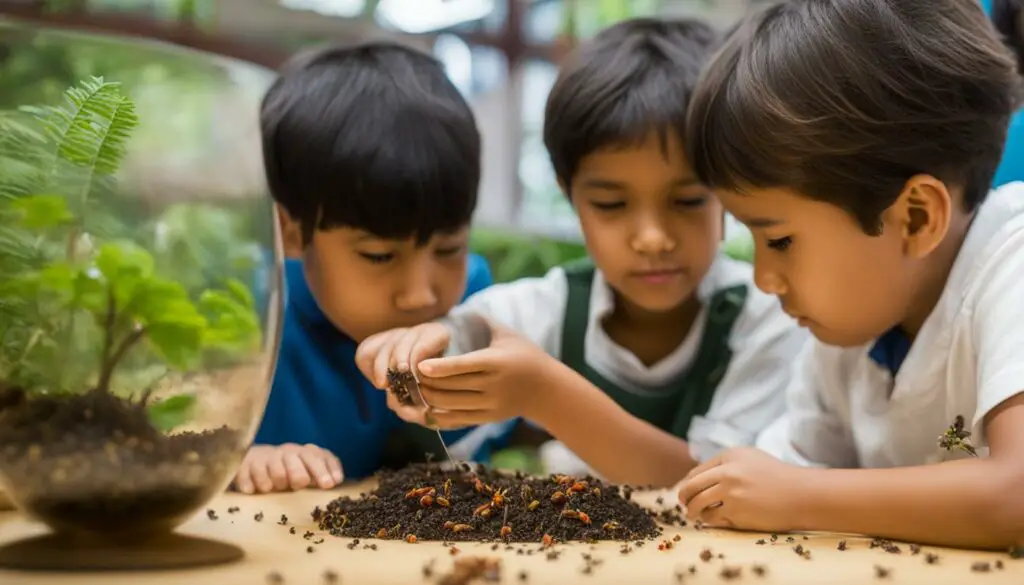
By promoting collaboration and observation in ant care, teachers create a dynamic and engaging learning environment. Students learn not only about ants but also about the importance of teamwork, communication, and careful observation in scientific exploration.
Ethical Considerations for Ants as Classroom Pets
When considering ants as classroom pets, it is essential to address the ethical considerations associated with responsible pet ownership. Teachers and students alike must prioritize the well-being of the ants and ensure their needs are met. This includes providing a suitable habitat, appropriate food and water sources, and a safe environment free from potential harm.
Responsible pet ownership extends to understanding the impact of captivity on the ants’ natural behavior. While ants can adapt to living in an ant farm or habitat, it is crucial to consider their innate instincts and provide opportunities for natural behaviors such as foraging and tunneling. Teachers should educate students about the importance of respecting the ants’ boundaries and refraining from causing harm.
Additionally, ethical considerations for classroom ants involve promoting conservation and understanding the ants’ ecological role. Teachers can engage students in discussions about the importance of ants in the ecosystem and their contributions to the environment. This fosters empathy towards these tiny creatures and encourages students to become stewards of the natural world.
Key Ethical Considerations for Classroom Ants:
- Providing a suitable habitat and meeting the ants’ basic needs
- Respecting the ants’ natural behaviors and instincts
- Ensuring a safe and harm-free environment
- Promoting conservation and understanding of the ants’ ecological role
| Ethical Considerations | Actions |
|---|---|
| Meeting the ants’ basic needs | Provide a comfortable habitat, appropriate food and water sources, and regular maintenance |
| Respecting the ants’ natural behaviors | Allow for natural behaviors such as foraging and tunneling, and avoid disrupting their activities |
| Ensuring a safe environment | Create a classroom environment that is free from potential harm or stress for the ants |
| Promoting conservation and understanding | Engage students in discussions about the importance of ants in the ecosystem and their ecological role |
By considering these ethical considerations, teachers can ensure that ants are kept as classroom pets responsibly, providing a positive and educational experience for students while prioritizing the well-being of the ants.
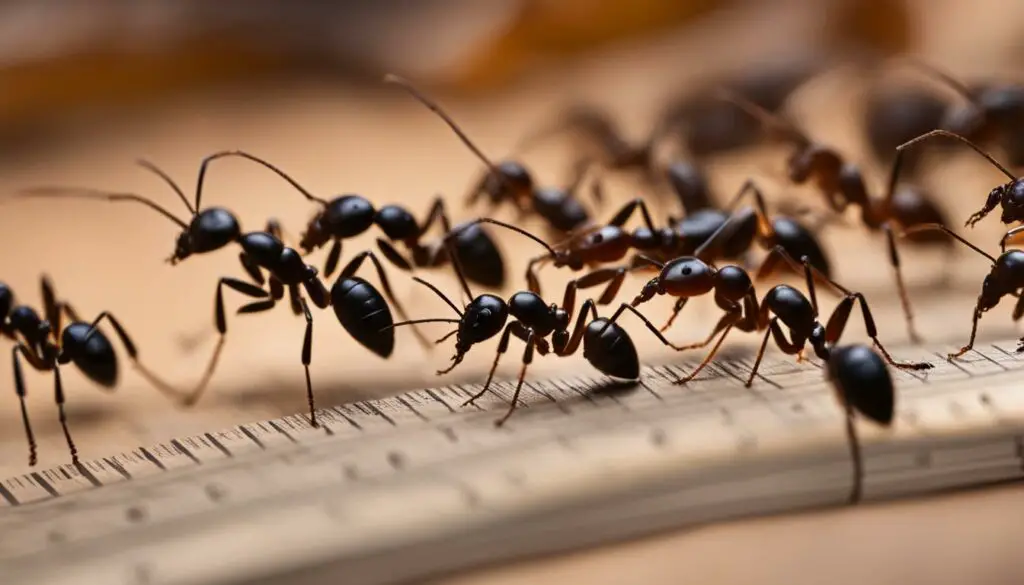
Assessing Student Learning with Ants
When incorporating ants as classroom pets, it is essential to assess student learning to evaluate the educational outcomes and the effectiveness of this teaching approach. By assessing student learning, teachers can gain valuable insights into the impact of ants on their students’ understanding, engagement, and overall educational experience. Various assessment methods can be employed to measure the learning outcomes associated with ants as classroom pets.
One effective assessment method is through observation checklists. Teachers can develop checklists that outline specific skills, knowledge, or behaviors they expect students to demonstrate when engaging with the ants. These checklists can include observing the ants’ behavior, identifying different ant species, or understanding the ecological role of ants. By observing students’ interactions with the ants and using the checklist as a guide, teachers can assess their understanding and progress.
Written reflections can also serve as a valuable assessment tool. Students can be encouraged to write about their experiences, observations, and insights gained from interacting with the ants. These written reflections provide an opportunity for students to demonstrate their understanding, critical thinking, and the connections they have made between their experiences with the ants and the concepts learned in class.
Additionally, project presentations and quizzes can be used to assess student learning. Students can create projects that showcase their understanding of different ant behaviors, ant anatomy, or the ecological impact of ants. Quizzes can test students’ knowledge on various ant-related topics, ensuring they have grasped the essential concepts and information. These assessments help teachers gauge the depth of students’ understanding and identify areas that may require further reinforcement or instruction.
Through a variety of assessment methods, teachers can evaluate the educational outcomes of incorporating ants as classroom pets. They can determine the effectiveness of this teaching approach, identify areas for improvement, and tailor their instructional strategies accordingly. Assessing student learning with ants allows for a comprehensive evaluation of the educational benefits and impact of ants as classroom pets.
Benefits Beyond the Classroom
Having ants as classroom pets offers numerous benefits that extend beyond the confines of the classroom. By engaging with ants, students have the opportunity to share their knowledge and experiences with their families and communities, fostering a deeper appreciation for these tiny creatures and the natural world. Here are some of the key advantages of ants as pets beyond the classroom:
- Environmental Awareness: Interacting with ants can ignite a passion for environmental conservation and sustainability. Students become more aware of the ecological role that ants play in their habitats and the importance of preserving biodiversity.
- Scientific Curiosity: Ants serve as a catalyst for scientific inquiry and exploration. Students are encouraged to ask questions, form hypotheses, and conduct investigations, sparking a lifelong interest in the scientific process.
- Community Engagement: Ants provide a platform for community involvement and outreach. Students can organize awareness campaigns, create educational materials, or even participate in local conservation efforts, promoting a sense of civic responsibility and active citizenship.
By incorporating ants into the classroom, teachers empower their students to become ambassadors for these remarkable insects, fostering a sense of wonder, scientific curiosity, and environmental stewardship in the broader community.
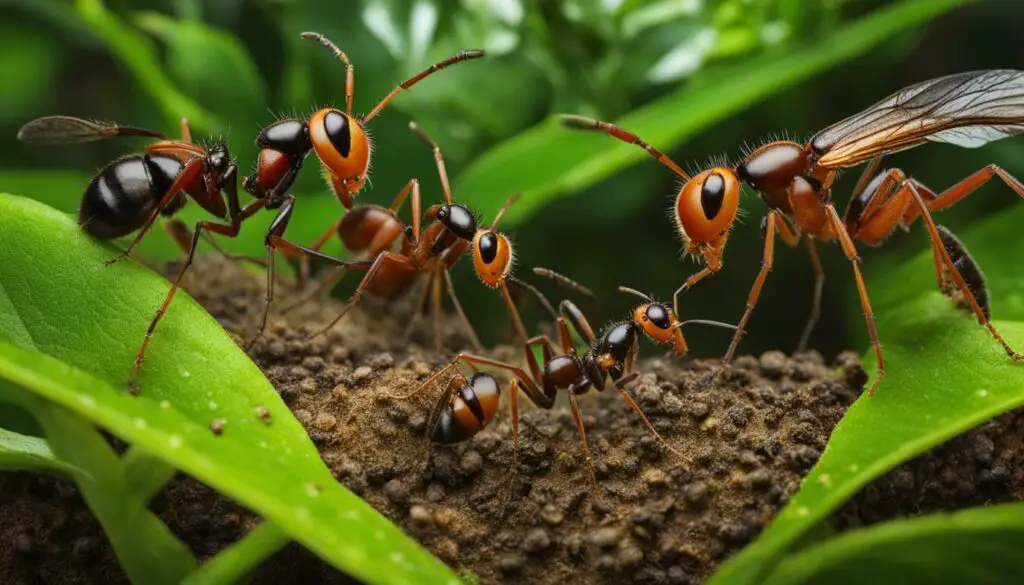
Quotes:
“Engaging with ants as classroom pets not only enhances the learning experience but also instills a sense of environmental awareness and encourages community engagement.” – Dr. Jane Stevens, Entomologist
“Ants offer a unique opportunity for students to connect with nature, fostering empathy, curiosity, and a deep appreciation for the natural world beyond the classroom.” – Sarah Thompson, Environmental Educator
Table: Benefits of Ants as Pets Beyond the Classroom
| Benefits | Description |
|---|---|
| Environmental Awareness | Students develop a greater understanding of the ecological role of ants and the importance of conservation. |
| Scientific Curiosity | Ants stimulate scientific inquiry, encouraging students to explore and investigate the natural world. |
| Community Engagement | Ant-related projects and initiatives promote community involvement and foster a sense of civic responsibility. |
Conclusion: Ants as Classroom Pets – Enhancing Learning and Fostering Responsibility
Throughout this article, we have explored the numerous benefits of having ants as classroom pets. From enhancing learning to fostering responsibility, ants offer a unique and interactive experience for students. By incorporating ants into the curriculum, teachers can create engaging and memorable lessons that promote critical thinking and curiosity.
The educational value of ants as pets is undeniable. Students have the opportunity to observe and learn about insect behavior, social organization, and the impact of environmental factors. Ant habitats serve as valuable teaching tools, allowing students to explore concepts in ecology, biology, and environmental science in a hands-on and meaningful way.
Observing ants in the classroom not only promotes scientific understanding but also contributes to students’ emotional well-being. Interacting with ants can reduce stress, foster a sense of calm, and improve mood. Furthermore, ants serve as companions, creating a nurturing and inclusive classroom environment.
By choosing the right ant species, incorporating ants into the curriculum, and providing a suitable habitat, teachers can ensure a safe and ethical environment for both the ants and the students. Ants as classroom pets offer benefits that extend beyond the classroom, inspiring community involvement and promoting a deeper appreciation for the natural world.
FAQ
Can ants be kept as classroom pets?
Yes, ants can be fascinating and educational classroom pets.
What educational benefits do ants offer in the classroom?
Ants promote learning, social development, and adhere to science and math standards.
What can students learn from observing ants?
Students can learn about insect behavior, social organization, and environmental impact.
How can ants be incorporated into science projects?
Students can conduct experiments and observations on ant behavior, exploring scientific concepts.
How can ants teach students responsibility?
Taking care of ants requires students to be accountable for feeding and providing suitable habitats.
How do classroom pets, like ants, benefit students’ emotional well-being?
Interacting with ants can reduce stress, promote calmness, and improve overall mood.
In which subjects can ants be integrated into the curriculum?
Ants can be incorporated into science, math, language arts, and art classes.
What factors should be considered when choosing ant species for the classroom?
Size, ease of maintenance, and compatibility with the classroom environment should be considered.
How can ants be safely kept in the classroom?
Teachers should ensure the chosen ant species does not pose any risks or allergies to students and establish hygiene protocols.
How can collaboration and observation be integrated into ant care?
Students can take on different roles, work together, and closely monitor the ants’ behavior.
What ethical considerations should be taken into account when keeping ants as classroom pets?
Teachers should meet the ants’ needs, promote respect, conservation, and empathy towards all living creatures.
How can student learning with ants be assessed?
Assessment methods such as observation checklists, reflections, presentations, or quizzes can be used.
What benefits can extend beyond the classroom when having ants as pets?
Students can share their knowledge with their families and communities, promoting interest in science and environmental conservation.

